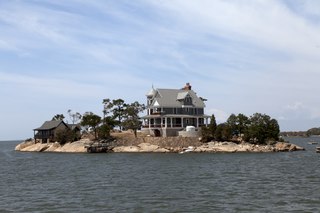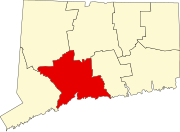
Branford is a shoreline town located on Long Island Sound in New Haven County, Connecticut, United States, about 6 miles (10 km) east of downtown New Haven. The town is part of the South Central Connecticut Planning Region. Branford borders East Haven to the west, Guilford to the east, and North Branford to the north. The population was 28,273 in the 2020 census.

The Fountainhead is a 1943 novel by Russian-American author Ayn Rand, her first major literary success. The novel's protagonist, Howard Roark, is an intransigent young architect who battles against conventional standards and refuses to compromise with an architectural establishment unwilling to accept innovation. Roark embodies what Rand believed to be the ideal man, and his struggle reflects Rand's belief that individualism is superior to collectivism.
The Stony Creek Puppet House was a theater in the Stony Creek section of Branford, Connecticut, near New Haven and the famed Thimble Islands. Built in 1903 as a movie theater, it became the home for community theater and summer stock productions. Orson Welles staged his short-lived stage production, Too Much Johnson, at The Stony Creek Theatre in 1938. After operating as a parachute factory during World War II, it became a puppet theater. The building is a Connecticut Historical Landmark that has been renovated as a live theater venue, the Legacy Theatre, which held its grand opening on April 23, 2021.
Bear Island is one of the Thimble Islands off Stony Creek, a section of Branford, Connecticut, USA. It is the site to a former granite quarry, which exported high-quality pink granite to such constructions as the Lincoln Memorial, Grant's Tomb and the base of the Statue of Liberty. The famous Stony Creek granite is still quarried in Stony Creek.
Rogers Island is one of the Thimble Islands off Stony Creek, a section of Branford, Connecticut. Also known as Yon Comis Island, Rogers bears a 27-room Tudor mansion, with tennis and basketball courts and a caretaker's residence on a 7.75-acre (31,400 m2) estate valued at $15.41 million. It sold in 2003 for $22.3 million to Christine Stoecklein Svenningsen, widow of party goods magnate John Svenningsen. It sold again, most recently, in August 2018 for $21.5 million.
Cut in Two Island, East and West, are two of the Thimble Islands off Stony Creek, a section of Branford, Connecticut. It is actually two separate islands, but, as the name suggests, it looks like a single island that was cleaved in two.

Outer Island is a 5-acre island located in Long Island Sound. It is one of the Thimble Islands, a small archipelago just south of Stony Creek, a hamlet of Branford, Connecticut. Outer Island is the southern terminus and most remote island found within this archipelago. It is on the ten units of the Stewart B. McKinney National Wildlife Refuge. The island was transferred to the United States Fish and Wildlife Service in 1995 by Elizabeth Hird. This island provides habitat for marine and avian wildlife.

Money Island is one of the Thimble Islands off Stony Creek, a section of Branford, Connecticut. It is named after a legend that Captain Kidd buried his treasure there. The island, 12 acres in size, bears an entire village of 32 houses, a post office, and one library. Former buildings included a school, a church, and a grocery store. There are three roads and several piers. At this time, none of the houses are occupied year-round.
Horse Island, at 17 acres, is the largest of the Thimble Islands off Stony Creek, a section of Branford, Connecticut. It is owned by Yale University and is maintained as an ecological laboratory by Yale's Peabody Museum of Natural History. It was purchased and donated to the university in 1971 as a convenient addition to the Yale Coastal Field Station in nearby Guilford, which has its own dock and boats, and is also managed by Yale's Peabody Museum of Natural History.
Governor Island is one of the Thimble Islands off Stony Creek, a section of Branford, Connecticut. It has 14 residences, although none are inhabited year-round.
Davis Island, one of the Thimble Islands off Stony Creek, a section of Branford, Connecticut, was the site of President William Howard Taft's "Summer White House".
Mother-in-Law Island is an island in the Thimble Islands group, part of the Stony Creek–Thimble Islands Historic District on Long Island Sound in Branford, Connecticut. It is also known as Johnson Island, Prudden Island, and Little Stooping Bush. One house, a frame-structured house built around 1965, stands on the island.

The Branford Steam Railroad is a 7.2-mile (11.6 km) standard-gauge industrial railroad that serves the Tilcon Connecticut stone quarry in North Branford, Connecticut, in the United States. It was founded in 1903 by Louis A. Fisk, a businessman from Branford, Connecticut, to transport passengers to a trotting park for horses. Fisk also chartered the Damascus Railroad in 1905 to extend the route of the Branford Steam Railroad to North Branford to serve quarries. The Damascus Railroad's charter was amended in 1907 to allow a further extension to the site of a new quarry adjacent to Totoket Mountain. The Branford Steam Railroad took control of the Damascus Railroad in 1909, and has been the operator since.

The Stony Creek–Thimble Islands Historic District is a historic district encompassing a 19th-century summer resort area in Branford, Connecticut. Located in the southeastern part of the town, it encompasses the mainland Stony Creek neighborhood, and all of the major Thimble Islands which lie offshore from Stony Creek in Long Island Sound. The district includes a well-preserved array of domestic summer resort architecture spanning more than a century preceding World War II, as well as worker housing and other artifacts related to the area's brief importance as a granite quarry. The district was listed on the National Register of Historic Places in 1988.

The Isaac C. Lewis Cottage is a historic house at 255 Thimble Islands Road in Branford, Connecticut. Built in 1882, it is a well-preserved example of an eclectically styled Victorian seaside summer house. The house was included in the Stony Creek-Thimble Islands Historic District in 1988, and separately listed on the National Register of Historic Places in 1997.

The William J. Clark House is a historic house at 32 Prospect Hill in the Stony Creek neighborhood of Branford, Connecticut. Built in 1878–80 to a design by New Haven-based architect Henry Austin, it is a particularly fine example of the Stick style of architecture popular at the time. The house is individually listed for its architecture on the National Register of Historic Places as the Stick Style House at Stony Creek, and is a contributing property to the Stony Creek-Thimble Islands Historic District.

The Thimble Islands is an archipelago consisting of small islands in Long Island Sound, located in and around the harbor of Stony Creek in the southeast corner of Branford, Connecticut. The islands are under the jurisdiction of the United States with security provided by the town of Branford police and the US Coast Guard.
Joseph Howard Stamler was an American lawyer and judge who served for seven years in New Jersey Superior Court, as well as a professor of law at Rutgers University. During his judicial career, Stamler was credited with having "handed down decisions of both statewide and national impact" on matters of significant public and social importance.
Gull Rock is a small rock ledge 542 feet off the coast of Madison in New Haven County, Connecticut. It is 883 square feet in size and made of glacial granite. It was named due to the large numbers of seabirds that rest there. Some parts of Gull Rock are covered in hardy plants during the summer months, and invertebrates thrive here. The island and its neighbors are occasionally considered to be part of the Thimble Islands, though this is uncommon. A steel seawall, now decrepit and unused, runs submerged from Gull Rock to the shore.

The Route 146 Historic District encompasses a historic streetscape in Branford and Guilford, Connecticut. Extending along Connecticut Route 146 between Flat Rock Road in Branford and the West River bridge in Guilford, it includes two centuries of rural residential architecture, and a well-preserved pre-World War II street layout created as a "state assistance road" in the 1920s. The district was listed on the National Register of Historic Places in 1990.












